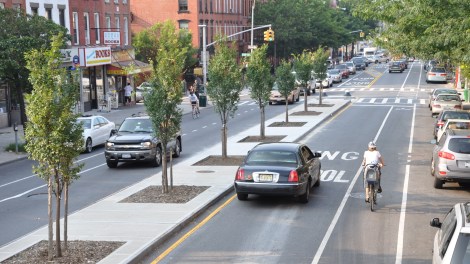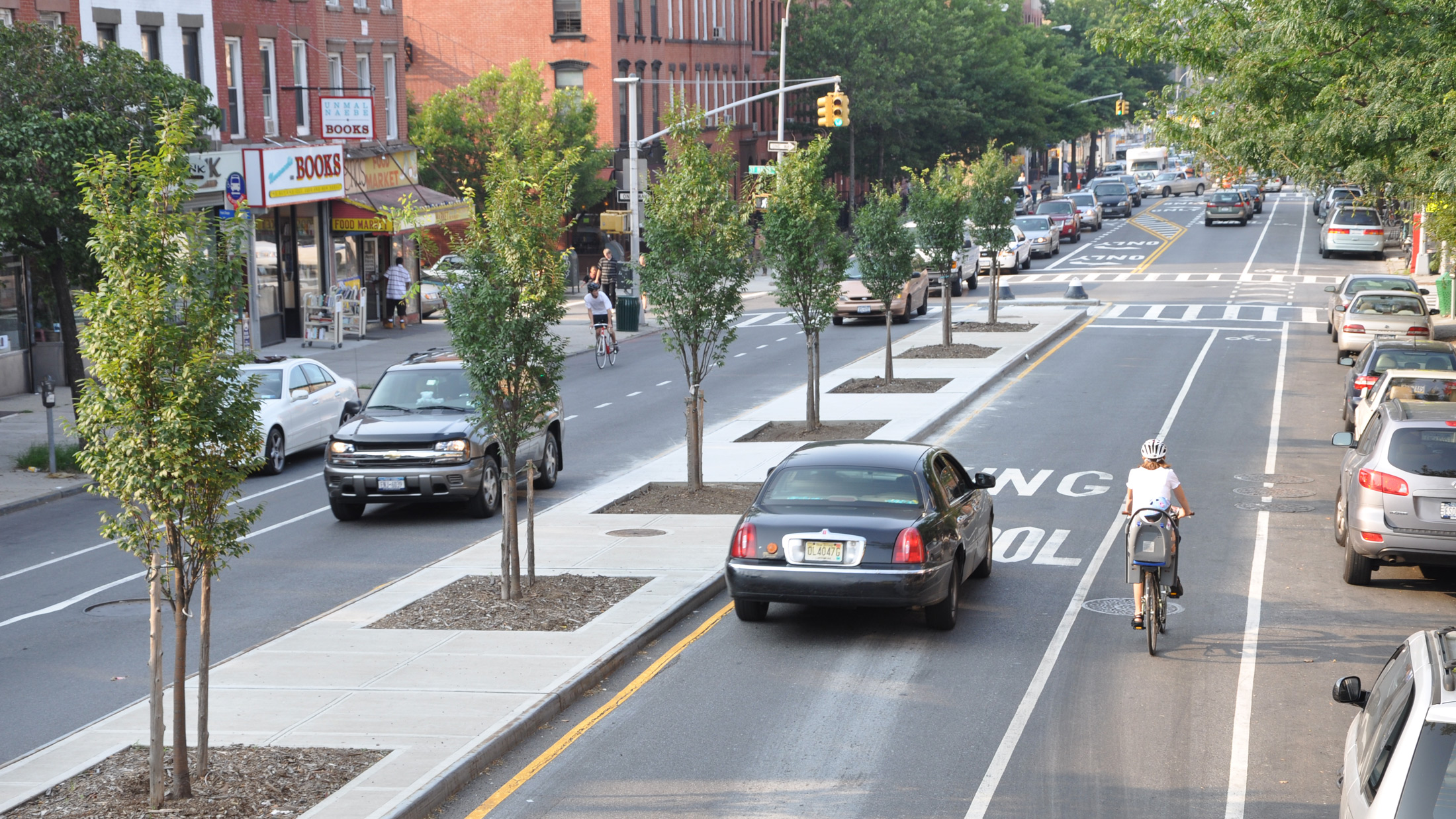
NYCDOTA tree-lined “complete street” grows in Brooklyn.
Earlier this month, a pair of senators introduced the Safe Streets Act. The bill would bring “complete streets” principles to federal road funding. Complete streets accommodate all users, regardless of whether they’re in cars, regardless of age or disability — pedestrians, bicyclists, wheelchair users, stroller pushers. In practice, this often means streets with sidewalks and bike lanes — two features that are often missing from roads built in the last half-century.
For too long, traffic engineers simply asked how to move cars as quickly as possible, rather than how to make streets safe to walk along or cross on foot. But now complete-streets policies have been adopted in more than 610 jurisdictions across the U.S., requiring local transportation departments to take the interests of non-drivers into account. The Senate complete-streets bill would require all federally funded road construction or repair to do the same.
So where are these two senators from? Presumably bastions of liberal, coastal urbanism like California or Massachusetts? Try Alaska and Hawaii. The sponsors are Sens. Mark Begich (D-Alaska) and Brian Schatz (D-Hawaii). Complete streets, it turns out, are appealing in lower-density areas too.
“This is not just an urban priority,” Schatz tells Grist. “It’s important for people to be able to move within their community safely.”
One reason complete streets are catching on is our aging population. Elderly people often give up driving because of deteriorating eyesight or other physical limitations. That’s why the AARP celebrated the bill’s introduction. Hawaii is a popular retirement destination. Having been built up in the late 20th century’s era of automobile tyranny, its streets often lack the sidewalks, crosswalks, and other accommodations elderly pedestrians require. “Hawaii is No. 1 for senior pedestrian deaths [per capita],” notes Schatz. “Our elderly pedestrians are killed at two times the national average. Twenty percent of all traffic fatalities in Hawaii are bicyclists and pedestrians. This is, first of all, an issue of keeping people safe.” Schatz was also inspired to sponsor the bill by his own personal experience walking his children to school in Honolulu along streets that often lacked sidewalks.
Complete-streets legislation is more broadly appealing than you might expect. Twenty-seven states, Puerto Rico, and Washington, D.C., have adopted complete-streets policies. A map of local governments that have also done so reveals many in unexpectedly rural, suburban, and conservative locales. Multiple towns in Idaho, Montana, Arizona, South Carolina, and Mississippi have signed on.
“There are a lot of smaller communities that are adopting it,” says David Goldberg, spokesperson for the National Complete Streets Coalition, a project of Smart Growth America. “Some of the early adopters were places you might expect, like Seattle and Chicago, that have been known for more pedestrian and bike-oriented policies. The wave over the last few years has been in the South and other places that have a legacy of boomtown development during the last half of the 20th century. They have a legacy of more dangerous roads from that era.” Goldberg points to the Mobile, Ala., metropolitan area as one where first smaller surrounding towns adopted complete-streets legislation, and then the city followed suit.
Republicans, despite their well-established aversion to investing in mass transit, are not necessarily always opposed to complete streets. Since they involve spending money more wisely rather than more in total, they should theoretically appeal to conservatives. And since they are especially important for elderly citizens — who constitute the GOP’s most supportive age demographic — the politics of complete streets are more congenial to Republicans than many other smart-growth initiatives. In Oklahoma City, the largest city in the reddest state in the nation, Republican Mayor Mick Cornett has promoted complete streets. Begich is running for reelection this year in a very Republican state, so he clearly believes complete-streets advocacy is an asset, or at least not a liability, for him there. The Senate bill is a companion to House legislation introduced last year by Reps. Doris Matsui (D-Calif.) and David Joyce (R-Ohio). It now has eight Republican cosponsors — Rep. Susan Brooks from Republican-leaning Indiana as well as others from Democratic-leaning or toss-up states.
“I think there is a desire in the Congress to find areas of common ground,” says Schatz. “Everybody intuitively understands the importance of sidewalks and wants to keep people safe.”
Does that mean the legislation will actually pass? Not if you’ve been following the news these last few years. The House Republican caucus is dominated by a reactionary wing that rejects bipartisan cooperation as an inherent sign of moral weakness. The value of sidewalks might seem universally obvious, but then so would the absurdity of defaulting on our national debt. So the bill is not a sure thing by any means. It’s also dependent on the progress of a larger surface transportation bill, which it would be rolled into. But unlike most good ideas proposed in Congress, it’s not an actual impossibility.




